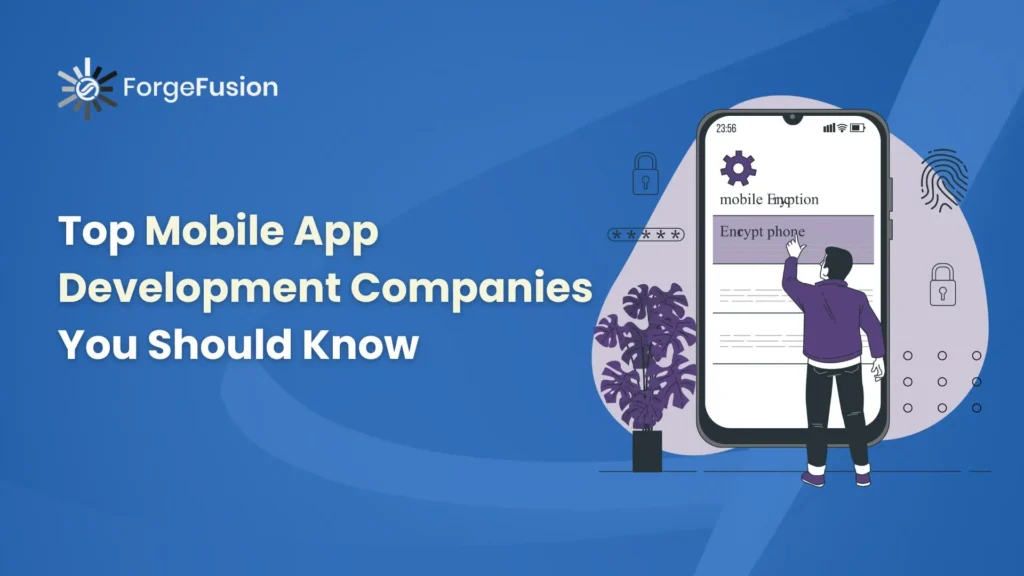Jumping into artificial intelligence (AI) is exciting. It’s for everyone – whether you’re just starting or you already know a lot and want to learn more.
Working on AI projects is a great way to be creative and really make a difference in the fast world of technology.
Think about being able to make things that solve big problems. AI can change many areas, like making healthcare better or helping businesses run smoother.
You can be part of this big change.
We’re going to look at cool AI project ideas together.
But first, let’s see why AI is so important. It’s not just a popular word; it’s a powerful tool that can open up many new chances.
AI can change how we live, work, and play by using things like machine learning and robotics.
And remember, AI is for everyone.
Now is a perfect time for students or anyone looking to try new things. AI projects are not just for learning; they help solve real problems and make the future better with technology.
So, are you ready to see what you can do with AI? Let’s start and see all the amazing things you can do.
What exactly are AI projects and how do they work
AI projects are like exploring new frontiers in the world of tech.
They’re about using artificial intelligence to solve problems and make things better or easier.
Imagine using AI to figure out what the stock market might do next, find out what’s making someone sick, or suggest the next movie you should watch on Netflix.

These projects are leading the way in creating new and exciting changes.
Here are just a few types of AI projects that you might come across:
Machine learning projects
These are like teaching a computer to learn from experience.
Just as you learn from your past and make decisions, machine learning projects train computers to recognize patterns and make smart choices on their own, without someone having to tell them what to do every time.
Computer vision projects
Imagine how self-driving cars navigate through streets or how your phone recognizes faces in photos.
This magic happens through computer vision projects, where computers are taught to see and understand pictures and videos, making sense of the world visually.
Natural Language Processing (NLP) projects
Ever asked Siri, Alexa, or Google a question and got an answer? That’s NLP at work.

These projects teach computers to understand and use human language, so they can talk to us, answer our questions, and even understand how we feel.
Robotics projects
Think of robots doing tasks like assembling cars, flying as drones to deliver packages, or even vacuuming your home.
Robotics projects focus on creating machines that can move, sense their surroundings, and perform tasks, sometimes in places where it’s hard or dangerous for humans to be.
All these AI projects aim to make artificial intelligence a helpful part of our daily lives, whether it’s by making data easier to understand, helping us communicate with technology, or even doing tasks for us.
Each type of project has its own special challenges, but they all push towards the same goal: using AI to make the world a better place.
So, no matter if you’re into data, talking to machines, or building them, there’s an AI project out there for you to dive into!
Why are AI projects beneficial for career opportunities
Here’s why diving into AI projects can really boost your career:
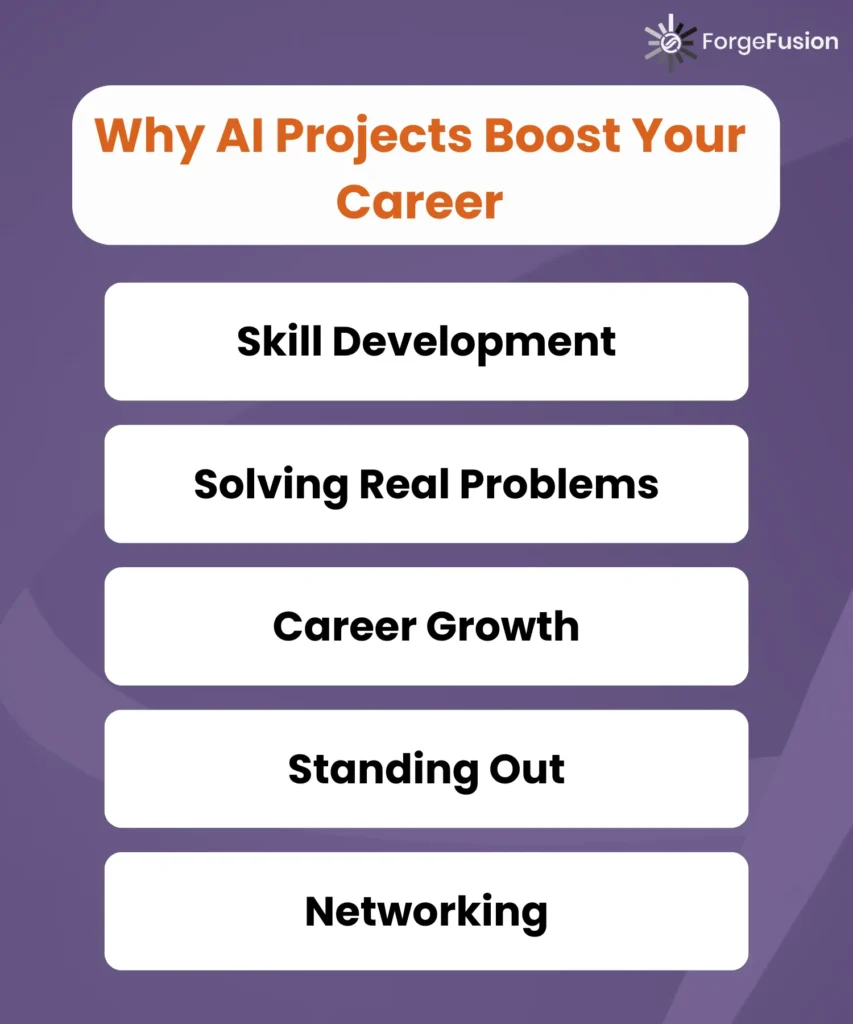
Skill development
Working on AI projects lets you get your hands dirty with coding, data crunching, and figuring out how machine learning works. It’s a practical way to learn and improve tech skills that are in high demand.
Platforms like Openai Agents make this journey even more enriching, it’s a website where you can find all the AI agents, AI tools, and the latest AI news, helping you stay updated and equipped with the right resources as you build and explore. For hands-on build support and faster production launches, consider partnering with machine learning development services
Solving real problems
AI projects often focus on solving big issues, from making healthcare better to helping the environment.
This means you get to use your brainpower to tackle challenges that matter, which sharpens your problem-solving skills and critical thinking.
Making a difference
By contributing to AI projects, you’re not just building your resume; you’re also making a positive impact on the world.
Whether it’s improving medical diagnoses or making energy use more efficient, your work can lead to real societal benefits.
Career growth
The world is hungry for AI expertise. By showing what you’ve achieved in AI projects, you open doors to a range of career paths, from data science to AI research.
There’s a growing need for smart, skilled people in sectors like healthcare, finance, and tech.
Standing out
Completing AI projects gives you something tangible to show employers, setting you apart from the crowd. It’s proof of what you know and what you can do.
Networking
Getting involved in AI projects can connect you with other people in the field, from peers to industry leaders.
These connections can lead to new opportunities, collaborations, and insights into where the industry is headed.
In short, AI projects are not just a learning experience; they’re a career accelerator.
They offer a unique blend of technical skill-building, problem-solving, and the chance to make a mark on the world, all while opening up new professional pathways.
How to come up with AI project ideas
You know, coming up with project ideas might seem daunting at first, but trust me, it’s not as hard as it seems.
Here’s how you can start with this:
- Look at what you love: Begin with your interests or areas you’re passionate about. Maybe you’re into gaming, healthcare, or making businesses run better. AI can play a role in all these fields.
- Spot the trends: Keep an eye on what’s happening in the world of technology and beyond. What challenges are industries facing today? Maybe it’s about making healthcare more accessible or predicting weather changes more accurately.
- Think about problems: Consider the big and small problems in the world. How could AI help? Maybe it’s by making roads safer or helping farmers grow more food. There’s no limit to the issues AI could tackle.
- Get inspired: Look at what others have done with AI. You might find projects that inspire you to think in a new direction or take an idea further.
- Make a list: Write down all your ideas, no matter how big or small. This list is your starting point.
- Choose wisely: Look at your list and think about which ideas are really possible. Do you have the tools, time, and resources to make them happen? Pick the ones that feel doable and could have a real impact.
- Set clear goals: Decide what you want your project to achieve. Having clear goals will help guide your project from just an idea to something real.
- Team up: Sometimes, two heads (or more) are better than one. Working with friends, classmates, or mentors can bring new perspectives and skills to your project.
Remember, the journey to finding a great AI project idea is about staying curious and not being afraid to explore.
Every big discovery starts with a question or a simple thought. So, keep asking, keep thinking, and you’ll find your way to an exciting project.
Easy AI project ideas for beginners
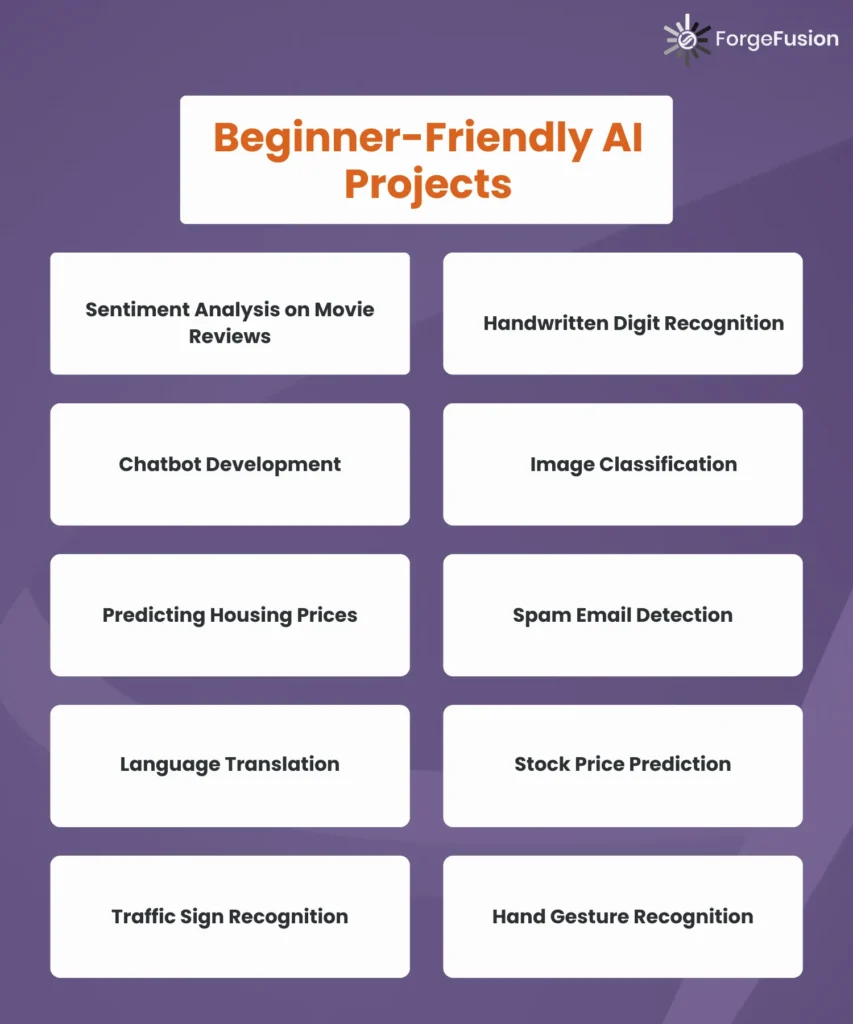
1. Sentiment analysis on movie reviews
Think about figuring out what people think about new movies. Sentiment analysis helps with this. It’s about looking at movie reviews and seeing if they’re good, bad, or okay.
Using technologies like natural language processing (NLP) and machine learning, you can make a system that sorts these reviews by feeling.

Why try this? Sentiment analysis is a big deal in AI and data science. It’s not just for movie reviews but also helps with checking out social media posts, customer opinions, and doing market studies. Doing this project lets you learn by doing with NLP and machine learning. Plus, you’re adding to a field that makes a real difference.
Here’s how to start with a sentiment analysis model for movie reviews:
- Find data: Get a bunch of movie reviews that say if they’re good or bad. You can find these online or make your own list.
- Clean the data: Fix up the text so it’s neat and tidy. This means taking out stuff you don’t need, breaking the text down into parts, and turning it into numbers the computer can use.
- Pick a model: Choose a machine learning tool, like Naive Bayes or an RNN, to figure out if the reviews are positive or negative.
- Test it: Check how good your model is at sorting reviews by using accuracy, precision, and recall. Then, make it better based on what you find.
2. Handwritten digit recognition
Imagine teaching a computer to recognize handwritten numbers. That’s what this project is all about. Handwritten digit recognition is a basic yet exciting challenge in machine learning. It’s perfect for beginners in image classification.
Why do this project? Recognizing handwritten numbers is key in AI, used in sorting mail to processing bank checks.
Through this project, you’ll learn about how to handle images and use machine learning. It’s also a first step towards more complex tasks like spotting objects in photos or cutting images into segments.
Here’s a simple way to start:
- Get data: Find a collection of handwritten numbers, like the MNIST dataset. It has loads of images of numbers with labels.
- Prepare images: Make the images ready by adjusting their brightness and size.
- Build a model: Use a machine learning model, like a convolutional neural network (CNN), to teach the computer to recognize the numbers.
- Check your work: See how well your model does by looking at accuracy and other measures. Keep tweaking your model to make it better.
3. Chatbot
Chatbots are the go-to for many businesses looking to step up their customer service game.
By tackling routine questions and offering instant help, chatbots not only make things run smoother but also cut down on costs and make customers happier.
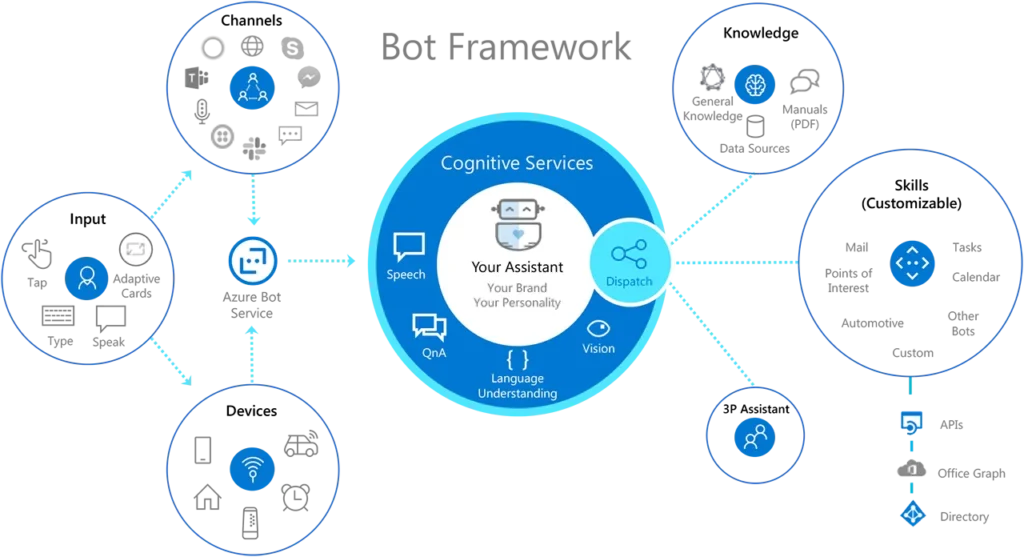
Plus, diving into chatbot creation is a cool way to get hands-on with natural language processing (NLP) and machine learning, two hot topics in AI.
Thinking about building one? You’ll need to pick the right tools first. There’s a bunch out there, like Dialogflow, Microsoft Bot Framework, or even Rasa for the open-source fans.
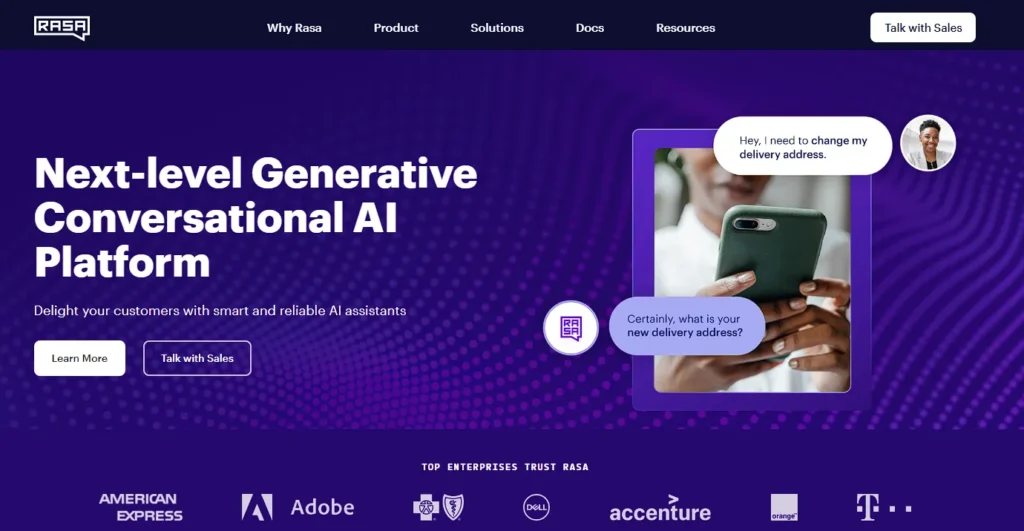
Figure out what your chatbot needs to do: Answer questions? Help users? Then, train it by feeding it conversations, so it learns the right responses. Keep tweaking it based on feedback, and measure how well it’s doing by seeing if people are actually getting the help they need from it.
Here’s a straightforward guide to kick things off:
- Choose your platform: Decide where your chatbot will live. Options include web services, social media platforms, or your own site.
- Pick your tools: Look into chatbot development tools like Dialogflow, Microsoft Bot Framework, or Rasa for those who prefer open-source solutions.
- Define its role: Clearly outline what tasks your chatbot will handle. Will it answer FAQs, guide users, or something else?
- Train your bot: Use real conversations to teach your chatbot the types of questions people will ask and the answers they should give.
- Test and tweak: Launch a beta version, collect feedback, and adjust accordingly. The goal is to improve its understanding and responses.
- Measure success: Keep an eye on how well it’s doing. Look at user satisfaction and how much it’s helping your business to ensure it’s making an impact.
4. Image classification
Image classification helps your phone and social media know what’s in your photos. It’s a cool part of AI that lets computers sort images into categories.
Why should you care? Well, it’s everywhere – from helping doctors spot diseases to making self-driving cars safer. Plus, diving into image classification gets you into computer vision, a super hot area in AI.
Want to get your hands dirty with image classification? Here’s how:
- Get your data: Find a dataset like CIFAR-10, ImageNet, or MNIST. These are collections of images already sorted into groups.
- Prep your pics: Resize images to a uniform size and adjust the colors so your computer can understand them.
- Pick a model: Use something like a convolutional neural network (CNN). It’s a type of AI model that’s good at seeing patterns in images.
- Train your model: Teach your model to recognize different categories by showing it lots of examples.
- Test and improve: Check how accurate your model is. Use tests to see where it’s getting confused and make it better.
5. Predicting housing prices
Predictive modeling lets you guess the price of houses in different areas with just a few clicks.
This project uses machine learning to look at past housing data and predict future prices based on things like location, size, number of bedrooms, and more. It’s super useful for real estate folks, investors, and homeowners.
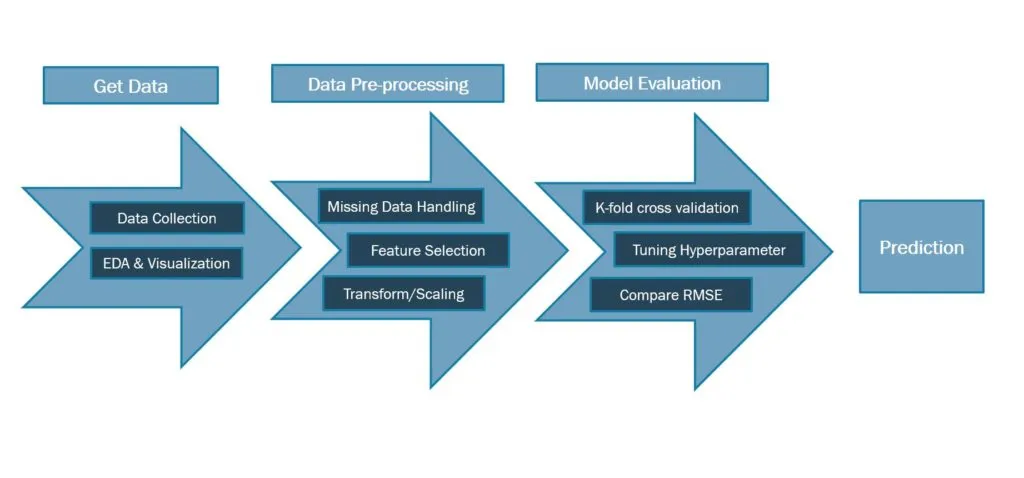
Why jump into this? Well, getting housing prices right can mean big money. If you’re buying or selling, knowing what a house is really worth can help you make smarter moves.
Plus, working on this kind of model lets you dive deep into regression, figuring out which features matter, and how to tell if your model is any good—all key machine learning skills.
Here’s how to start:
- Grab some data: Look for historical housing price info with details on location, size, features, and what they sold for. Sites like Zillow or datasets on Kaggle can be goldmines.
- Clean it up: Fix any missing bits, make sure categories are clear, and get all the numbers on a similar scale.
- Pick your model: Try out linear regression or maybe a decision tree to see patterns in the data and start making guesses.
- Test your work: Use stats like mean squared error or R-squared to see how close your predictions are and tweak your model to get better.
6. Spam email detection
Spam email detection helps you clear out all those annoying, useless emails so you can see the important stuff. It’s a tool that’s not just handy for you but crucial for keeping business and organization email systems safe.
Why dive into this? For starters, it keeps your inbox clean and lowers the chance of you clicking on something dodgy.
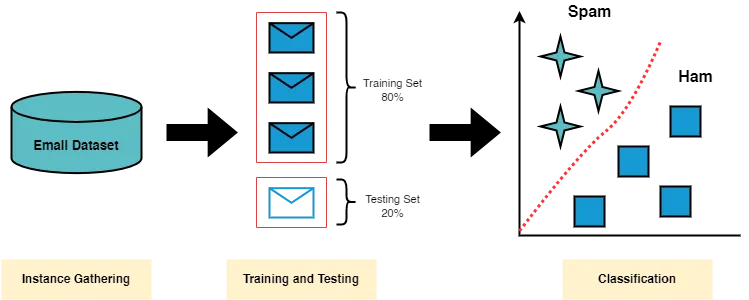
Plus, working on spam detection means you get to play around with some cool stuff like classification algorithms, figuring out how to process and understand text, and pulling out the important bits of info—all key parts of natural language processing (NLP) and machine learning.
How to get going with spam email detection:
- Collect emails: You need a bunch of emails that are already marked as spam or not spam. You can find datasets online or make your own list from different sources.
- Prep the text: Get rid of filler words, break down words to their roots or base forms, and turn the text into numbers using stuff like TF-IDF or word embeddings.
- Choose your fighter: Pick a machine learning model like logistic regression or a support vector machine (SVM) to start sorting emails into spam or not spam.
- Make it better: Check how well your model’s doing with accuracy, precision, recall, and F1-score, and adjust things to improve its performance.
7. Language translation
Language translation helps knock down language barriers, letting us chat easily with folks from all over.
This project is about making a system that automatically changes text from one language to another, smoothing out communication across different languages. It’s super useful for stuff like doing business internationally or helping travelers get around in new places.
Why get into this project? First off, tackling language translation dives deep into natural language processing (NLP), a huge area with lots of real-world impact.
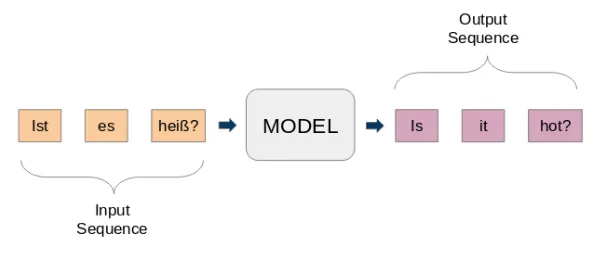
Getting good at translating languages not only sharpens your skills in handling multilingual communication but also plays a part in connecting people worldwide.
Plus, making a language translation model means you get to mess around with some of the coolest tech in AI, like sequence-to-sequence models, attention mechanisms, and neural machine translation.
Here’s how to start:
- Find data: You need texts that are aligned, meaning they’re the same sentences in two different languages. Check out resources like the Europarl corpus, TED Talks translations, or the Multi30k dataset.
- Prep your text: Break down sentences into words or pieces, make lists of all the words used, and make sure each text chunk is the same length.
- Train your model: Use models designed for translation, like sequence-to-sequence models with attention, or the newer transformer models, to learn how to switch between languages.
- Check your work: Use scores like BLEU or METEOR to see how well your model translates, and keep tweaking it to get better results.
8. Stock price prediction
Stock price prediction lets you take a stab at guessing where the stock market’s headed, giving investors a heads-up on what moves to make.
This project is all about creating a system that looks at past stock market data to predict future prices, helping investors spot good deals and avoid bad ones.
Why dive into stock price prediction? For starters, it’s a tough nut to crack but can be super rewarding with big financial upsides. Getting it right means you’ve got skills in analyzing time series data, picking out important features, and building models that can guess what comes next—key skills for anyone into quantitative finance or algorithmic trading.

Stock prediction isn’t just for making bets on the market, either. It’s also about managing risk, optimizing portfolios, and figuring out market trends, which are all super important for financial pros and big institutions.
Here’s how to get rolling:
- Collect data: You need historical stock data, like open and close prices, volume, and other market indicators. Grab this from financial sites, APIs, or places like Yahoo Finance.
- Prep the data: Fix any gaps, scale the numbers so they’re comparable, and split your data into chunks for training and testing.
- Pick a model: Try out different models, from simple linear regression to more complex time series models like ARIMA, or even deep learning models like LSTM, to see what predicts stock prices best.
- Evaluate and adjust: Use metrics like mean squared error or R-squared to see how close your predictions are to what actually happened, and tweak your model for better accuracy.
9. Traffic sign recognition
Traffic sign recognition lets a car’s computer see and understand traffic signs on the road, guiding drivers safely.
This project is all about creating a system that can spot and figure out different traffic signs from camera images—think speed limits, stop signs, and where it’s safe to walk.
It’s a big deal for things like self-driving cars, helping out drivers, and making smarter roads.
Why jump into this? Traffic sign recognition is key for the tech in advanced driving help and autonomous vehicles, which are big areas in computer vision and AI.
By tackling this project, you dive into image classification, spotting objects, and using convolutional neural networks (CNNs)—all crucial for making smart systems that get the real world. Plus, it’s a step toward making roads safer and driving smoother for everyone.
Here’s how to start:
- Find data: Grab a dataset of traffic sign images that are marked with what each sign is. The German Traffic Sign Recognition Benchmark (GTSRB) and LISA Traffic Sign Dataset are good places to start.
- Prep the images: Resize them so they’re uniform, adjust the colors to make processing easier, and tweak the data to cover more variations.
- Train a model: Use a CNN or a deep learning approach like YOLO to teach your system to recognize and classify signs from images.
- Measure and improve: Check out how accurate your model is and how well it spots and understands signs, using stats like accuracy and precision. Keep adjusting to make it better.
10. Hand gesture recognition
Controlling gadgets with a simple hand wave isn’t just movie magic anymore—hand gesture recognition is making it possible.
This project is about creating a system that looks at pictures or videos of hand movements and figures out what those gestures mean, like turning on lights or playing video games.
It’s a game-changer for things like translating sign language, making tech easier to use, or creating cooler gaming experiences.
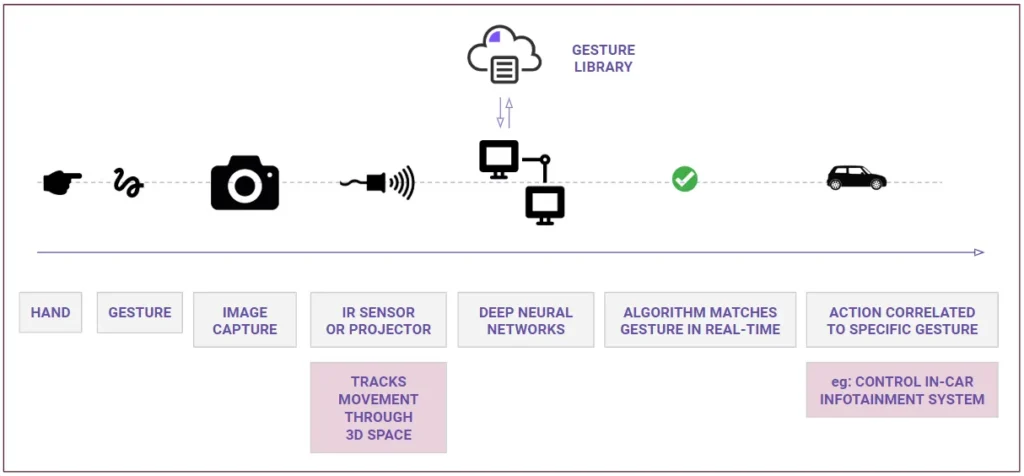
Why get into hand gesture recognition? It’s a super cool challenge with the power to change how we interact with our tech.
Digging into this project means you’ll learn a ton about computer vision, recognizing patterns, and understanding gestures, which are key for making smart systems that get human movements.
Plus, this tech has a huge range of uses, from healthcare and education to entertainment and robotics, making it a really versatile area to explore.
Here’s how to kick things off:
- Gather data: Start with a collection of hand gesture images or videos that are marked with what each gesture means. The American Sign Language (ASL) Alphabet dataset and the Hand Gesture Recognition Database (HGR) are great places to look.
- Prep the data: Pull out important details from the images or videos, like the shape of the hand, where it is, and how it moves.
- Choose your model: Train a model, like a convolutional neural network (CNN) or a recurrent neural network (RNN), to recognize these gestures and connect them to actions or commands.
- Test and tweak: Use measures like accuracy and precision to see how well your model’s doing, and adjust it to improve.
Intermediate level AI project ideas
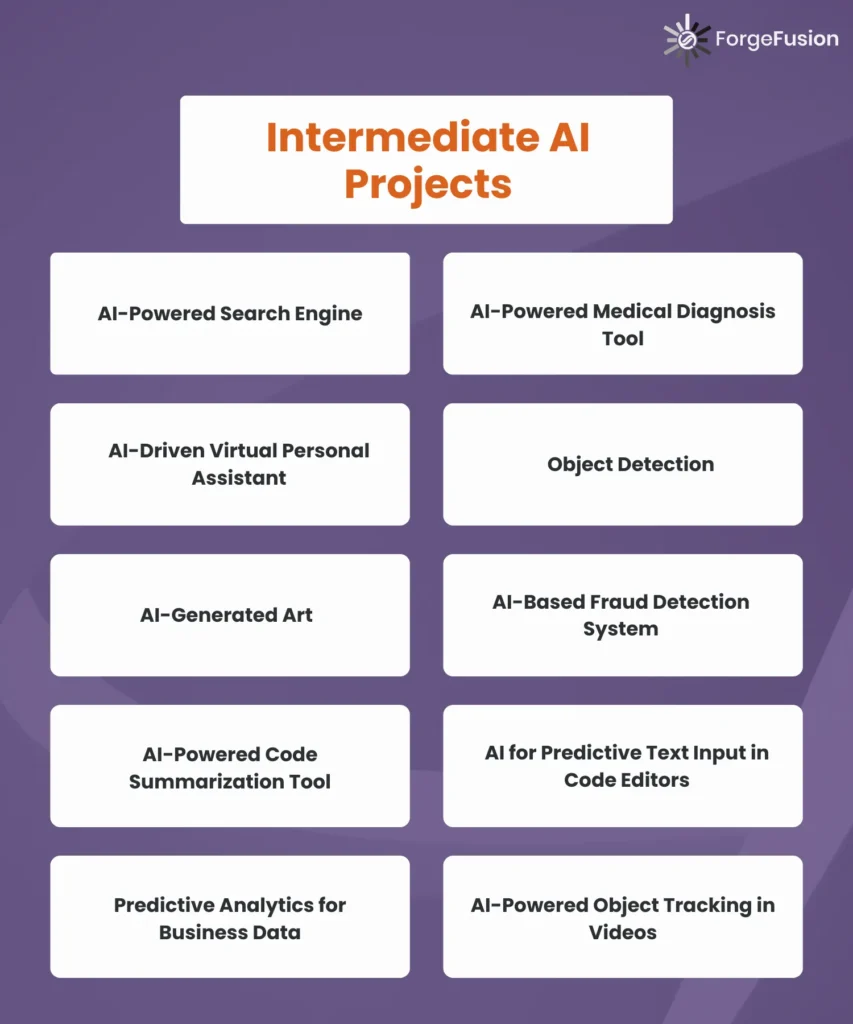
11. AI-powered search engine
Imagine searching the web and finding exactly what you need right away. That’s what an AI-powered search engine offers. It uses artificial intelligence to make searching online much smarter, giving you more accurate and relevant results fast.
These search engines are way better because they get what you’re really looking for, dig into the meaning of content, and sort results in a way that makes sense for you.
Why dive into making one? Traditional search engines might miss the mark because they just look at keywords and which pages are popular. With AI, you can make searching feel more like talking to someone who really understands what you need.
Plus, AI search engines can be a game-changer in all sorts of fields by helping people make better choices and find what they need faster.
Here’s how to get started:
- Collect data: You need lots of web pages or documents, and data on how people search for stuff.
- Prep your data: Extract important bits from your data, create embeddings to capture the essence of the content, and set up indexes for quick searching.
- Use AI models: Implement machine learning, like NLP or deep learning, to make your search engine understand and predict what users want.
- Keep improving: Track how well your search engine does with metrics like precision and user happiness, and tweak it to keep getting better.
12. AI-powered medical diagnosis tool
Creating an AI-powered medical diagnosis tool means building a smart system that can help doctors figure out what’s wrong with a patient and suggest treatment options.
This kind of tool can look at symptoms, patient history, test results, and more to help healthcare pros make better decisions, faster.
Why jump into this project? Diagnosing diseases is tough and takes a lot of skill and knowledge. With AI, you can boost doctors’ ability to diagnose quickly and accurately, making sure patients get the care they need sooner.
Plus, these tools can make quality healthcare reachable for people in far-off places or where there’s a shortage of doctors.
Here’s how to get cracking:
- Gather data: You need lots of medical info, like patient records, health records, images from scans, and data from clinical studies.
- Prep the data: Clean it up, make sure it’s consistent, and protect people’s privacy by removing personal info.
- Build your model: Use machine learning, like algorithms that sort data, deep learning, or methods that combine multiple approaches, to sift through the data, spot patterns, and make predictions about health issues or treatments.
- Test it out: Check how well your tool works with clinical trials, reviews by medical experts, and tests in real-life medical settings to make sure it’s safe and effective.
13. AI-driven virtual personal assistant
Building an AI-driven virtual personal assistant means crafting a digital buddy that helps you handle your daily tasks, keeps your schedule straight, and even suggests stuff based on what it learns about you, all through a quick voice command.
Virtual assistants like Siri, Alexa, and Google Assistant have already started changing how we interact with our gadgets, making life a bit easier and more connected.
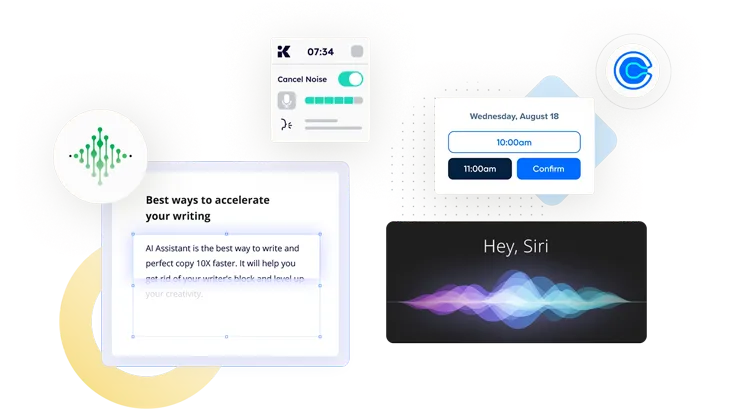
Why dive into making one yourself? These assistants are great at making life smoother by taking care of the little things, helping you manage too much information, and making it easier to stay in touch.
Making your own assistant lets you deep dive into natural language processing (NLP), speech recognition, and making computers chat like humans—skills that are super hot right now in tech.
Plus, these assistants can make tech easier to use for everyone, including folks with disabilities, older people, and those who speak other languages, making sure everyone gets a piece of the future.
Here’s a blueprint to get you started:
- Craft a chat interface: Make a system that can chat with users in a natural way, understanding and answering their questions and commands.
- Add understanding and speech: Bring in speech recognition to catch what users say and natural language understanding (NLU) to grasp the meaning behind the words, plus manage the flow of conversation.
- Personalize and manage tasks: Work on algorithms that suggest stuff based on what the assistant learns about the user, help keep track of tasks, and even hook up with other services to do more things.
- Iterate and improve: Keep making your assistant better by looking at how people use it, what they need, and what new tech comes out, ensuring it stays helpful and fun to use.
14. Object detection
Teaching computers to “see” and recognize objects in images or videos is what object detection is all about. It’s a project that involves creating algorithms to analyze visual data and pinpoint objects within that data.

This tech has tons of uses, from helping cars drive themselves to keeping an eye on places for security, making virtual worlds more realistic, or even spotting details in medical images.
Why should you get into object detection? It’s a key challenge in computer vision, and getting good at it means you’ll learn a lot about analyzing images, pulling out important details, and using machine learning to make sense of what you see.
This can lead to big improvements in safety, how things are made, healthcare, and even shopping, by giving machines a bit of human-like sight.
Ready to build an object detection system? Here’s a game plan:
- Get data: Find a bunch of images or videos that already show and point out various objects. Look into datasets like COCO, Pascal VOC, or Open Images for starters.
- Prep your data: Mix up your images a bit (this is called augmentation), resize them so they’re uniform, and adjust their colors to make it easier for your model to learn from them.
- Train your model: Pick a machine learning model, like a convolutional neural network (CNN) or something more specific for spotting objects, like Faster R-CNN or YOLO, and teach it to recognize and locate objects.
- Measure success: Use metrics like mean Average Precision (mAP) and Intersection over Union (IoU) to see how well your model’s doing, and keep tweaking it to get better at spotting what’s in your images.
15. AI-generated art
Using artificial intelligence to craft breathtaking art that stretches the limits of creativity and imagination is what AI-generated art is all about.
It’s a blend of machine learning magic that can take on painting, drawing, sculpting, and even creating music and poetry, making waves in the art world by producing unique, eye-catching works.
Why venture into AI-generated art? It’s where tech meets art in an exciting way, letting you test the limits of what’s possible in art through the lens of AI.
With AI art, you can rethink what it means to create, opening up debates on creativity’s origins and technology’s role in art.
Plus, it makes art more accessible, giving anyone with a computer the chance to dive into art creation, regardless of their traditional artistic skills or resources.
How do you start making AI-generated art?
- Gather art data: Collect images or artworks to teach your AI about different artistic styles.
- Prep your data: Resize and standardize your images, and maybe mix them up a bit to help your model learn better.
- Train your model: Use something like a generative adversarial network (GAN) or a variational autoencoder (VAE) to digest the essence of these styles and spit out new, original art pieces.
- Critique and refine: Look at what your AI’s producing in terms of beauty, originality, and how well it sticks to different art styles. Keep tweaking your system to up its art game.
16. AI-based fraud detection system
Creating an AI-based fraud detection system lets you automatically spot and stop fraud as it happens, potentially saving businesses a ton of money.
This kind of project uses machine learning to sift through transaction data, pick out what doesn’t look right, and flag those transactions that need a closer look.
For banks, online shops, and pretty much any company dealing with payments, having a sharp system like this is key to fighting fraud and keeping their customers’ trust.
Why dive into this? Fraud is a huge issue that costs industries billions yearly. With an AI system tailored for spotting fraud, you can help cut down on those losses and protect both businesses and their customers.
Plus, these systems get smarter over time, learning from new data to get even better at catching fraud.
Here’s a roadmap to building your own AI-based fraud detection system:
- Collect transaction data: You need details like how much was spent, where, when, and any patterns in how users spend.
- Prep the data: Clean it up, get it all to match up, and arrange it so your machine learning models can digest it.
- Pick a model: Try different machine learning approaches, like logistic regression, decision trees, or neural networks, to see which best separates the good transactions from the bad.
- Measure and improve: Use metrics like precision and recall to gauge how well your system is doing. The goal is to catch as much fraud as possible without too many false alarms. Keep tweaking your model to boost its accuracy and reliability.
17. AI-powered code summarization tool
Creating an AI-powered code summarization tool means you’re building a system that can automatically simplify complex code into easy-to-understand summaries.
This leverages natural language processing (NLP) and machine learning to dig through code, pinpoint its main purposes, and put that into plain language.
Such tools can make life a lot easier for developers, especially when dealing with big projects, by helping them grasp what different parts of the code do without having to comb through every line.
Why is this worth your time? Code summarization tackles a real headache in software development: getting the gist of what code does, fast.
With an AI tool for this, you’re not just making developers’ lives easier but also speeding up how teams understand and work with code, which is super helpful for bringing new team members up to speed or coordinating work across different locations.
Here’s a step-by-step to get this project going:
- Collect data: Start with a bunch of code snippets and their explanations or summaries. This will be the food for thought for your AI.
- Prep the data: Break down the code into manageable pieces, pull out key features, and get everything ready for the AI to learn from.
- Train a deep learning model: Use advanced models, like sequence-to-sequence or transformer models, to teach your AI the art of turning code into summaries.
- Test and refine: Check how well your tool is doing with metrics like BLEU and ROUGE scores, or how well it captures the code’s essence, and keep improving it to get even better summaries.
18. AI for predictive text input in code editors
Dreaming of a smarter autocomplete in your code editor that helps speed up your coding and cuts down on errors? AI for predictive text input in code editors is your answer.
This tech uses machine learning to figure out what you’re likely to type next, based on the code you’re already working on, giving you suggestions that fit like a glove.
This kind of AI assistance has been making waves in popular code editors like Visual Studio Code, PyCharm, and Sublime Text, making coding a smoother, faster process.
Why jump into creating AI for predictive text in code editors? It’s all about boosting efficiency. This AI can save developers a ton of time, help avoid pesky errors, and even introduce programmers to new ways of doing things through smart suggestions.
Plus, it can make code cleaner and more consistent by nudging developers towards best practices and clever solutions.
Ready to build it? Here’s how:
- Collect data: You’ll need loads of code snippets, bits of programming languages, and context clues. This data trains your AI to understand coding patterns.
- Prep the data: Break down your code snippets into tokens, sort out the features, and set up your training data.
- Train a language model: Use something like a recurrent neural network (RNN), a transformer model, or a pointer-generator network to grasp the nitty-gritty of coding languages and predict what comes next.
- Integrate and test: Plug your AI into a code editor and see it in action. Keep an eye on how well it does, asking real users for feedback, and tweak it to make sure it’s offering valuable and accurate suggestions.
19. Predictive analytics for business data
Predictive analytics gives you the superpower to see into the future of business, spotting trends, dodging risks, and making smart moves that boost growth.
This project taps into machine learning to sift through past business activities, finding patterns and connections, and cooks up models that can predict what’s next. It’s a game-changer in various sectors, helping companies fine-tune their operations, minimize risks, and jump on new opportunities in a fast-paced market.
Why dive into this? Predictive analytics pulls out actionable insights from data piles, giving businesses the upper hand in decision-making and keeping them a step ahead of rivals.
By crafting these models, you can forecast critical metrics like sales, customer behavior, stock needs, and more.
This not only helps in smarter resource distribution, better marketing, and happier customers but also opens doors to fresh revenue paths, sparks innovation, and could even flip old-school business practices on their head with new data discoveries.
Here’s how to get rolling with predictive analytics for business:
- Gather historical data: You need a solid base of business info, like sales history, who’s buying what, market movements, and other key details.
- Prep your data: Clean it up, shape it, and make sure it’s consistent, setting a strong foundation for your models.
- Choose your algorithms: Pick from machine learning heroes like linear regression, decision trees, random forests, or neural networks, aiming to match historical patterns to future forecasts.
- Measure and enhance: Use metrics like accuracy, precision, and mean absolute error to judge your models. Keep tweaking to boost their forecasting power and their ability to generalize well to new, unseen data.
20. AI-powered object tracking in videos
AI-powered object tracking lets you automatically spot and follow objects in videos, opening doors to cool stuff like better security systems, smarter video analysis, and fun augmented reality experiences.
This project is all about crafting computer vision algorithms to sift through video frames, pick out objects, and keep an eye on them as they move. From keeping tabs on important places to guiding self-driving cars and enhancing sports broadcasts, the uses are vast and varied.
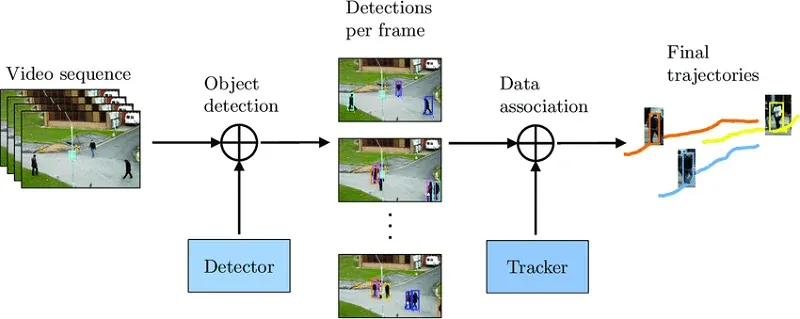
Why dive into this? Object tracking is a big deal in computer vision, crucial for a bunch of industries.
By developing systems that can track objects, you’re not just upping security or making videos easier to analyze; you’re also paving the way for new tech in augmented reality, virtual reality, and interactive entertainment, offering real-time interactions with the physical world.
Here’s a plan to build your own AI-powered object tracking system:
- Collect annotated videos: Start with videos that have already been marked to show where objects are in each frame.
- Prep your data: Pull out important features, calculate how objects move, and adjust your data to capture these movements and changes over time.
- Train your model: Use machine learning—think convolutional neural networks (CNNs), recurrent neural networks (RNNs), or a mix—to learn how to spot objects and track where they go in the video.
- Test and tweak: Check how well your system tracks objects using measures like accuracy and intersection over union (IoU). Fine-tune it to handle real-life scenarios better.
Advanced level AI project ideas
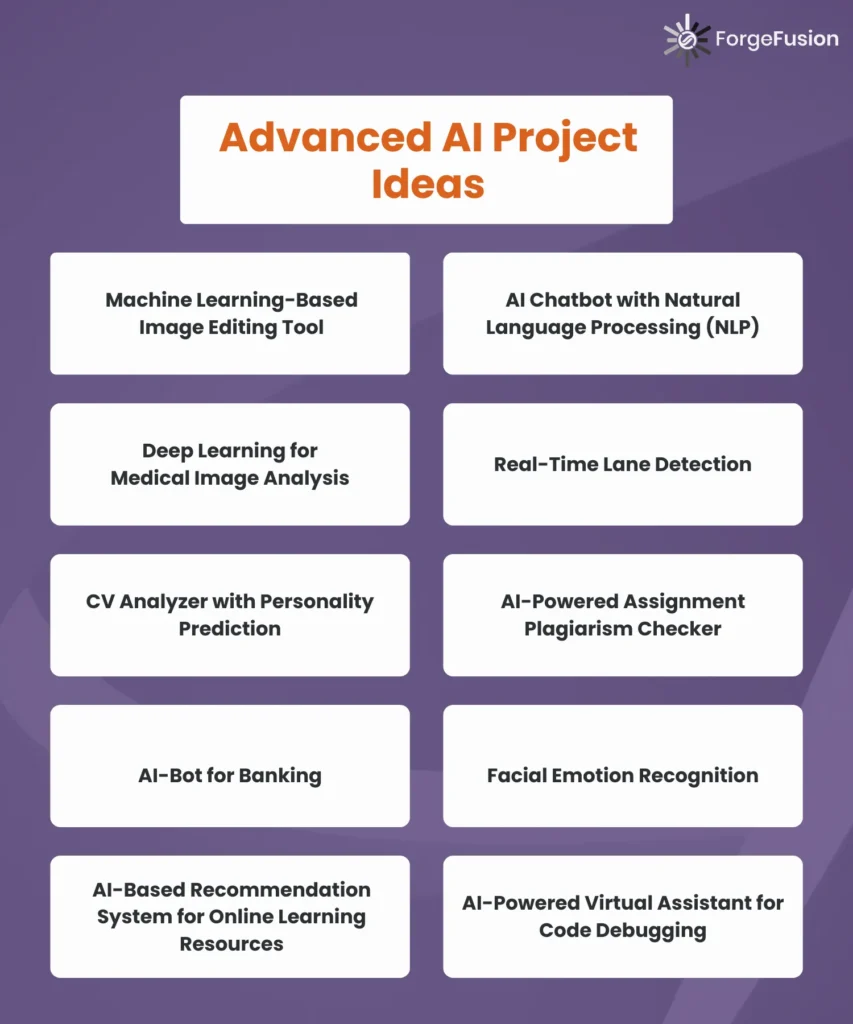
21. Machine learning-based image editing tool
A machine learning-based image editing tool is like wielding a magic wand that transforms, enhances, and edits images with a few clicks, all thanks to advanced machine learning algorithms.
This project is about crafting a smart software that uses these algorithms to automate editing tasks—think fixing colors, erasing unwanted objects, or even applying artistic styles to photos.
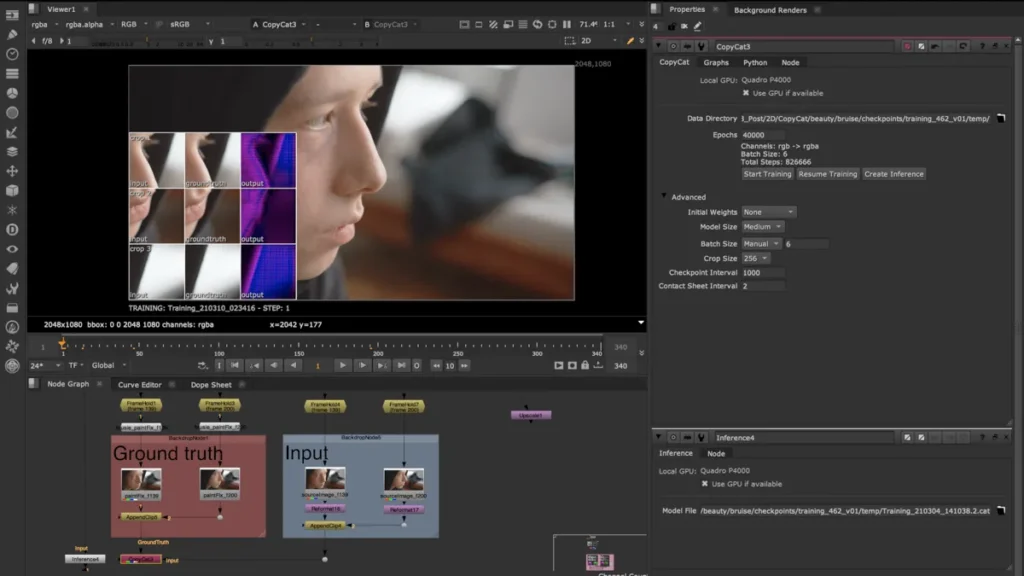
As digital photography and social media grow, so does the craving for easy-to-use tools that let people make their images stand out without needing a degree in graphic design.
Why jump into this project? Traditional photo editing tools can be daunting with their steep learning curves and complex techniques.
By creating a machine learning-powered editor, you’re opening up the world of image enhancement to everyone, making it super easy for anyone to polish their photos and express their creative vision.
Here’s how to start building your own machine learning image editing tool:
- Collect annotated images: You’ll need a bunch of images that show both the original state and the edited version, covering changes like brightness tweaks, contrast boosts, and removing elements.
- Prep the data: Extract important features from these images, like color patterns, textures, and layout, to help your algorithm understand what makes a good edit.
- Train your models: Dive into machine learning with models like convolutional neural networks (CNNs), generative adversarial networks (GANs), or autoencoders. These models will learn how to turn the before images into the after based on your dataset.
- User-friendly interface: Wrap up your models in an easy-to-use app where users can drop in their photos and play around with automated edits, seeing the magic happen in real time.
22. AI chatbot with Natural Language Processing (NLP)
Creating an AI chatbot powered by natural language processing (NLP) means you’re setting up a smart conversational agent that can chat with users, understand their needs, and help out right away.
These AI buddies are becoming a big deal on messaging apps and as virtual helpers, offering tailored support, answering questions, and handling tasks without breaking a sweat.
Why should you dive into making one? AI chatbots are changing the game in customer service and beyond, making interactions smoother in sectors like retail, healthcare, finance, and education.
By bringing NLP into the mix, your chatbot can grasp what users mean, catch the vibe of the conversation, and reply in a way that feels natural and helpful, boosting user happiness and making communications more efficient.
Here’s a plan to get you started on your AI chatbot:
- Gather conversational data: You’ll need a collection of dialogues, showing how real chats go down, to teach your bot about human conversation.
- Prep the data: Break down the text into manageable pieces, clear out any fluff, and turn words into numbers so your machine can understand.
- Train your models: Use advanced models like recurrent neural networks (RNNs), transformers, or sequence-to-sequence models to help your bot learn how to match questions with the right answers.
- Bring it to life: Put your trained chatbot into action on a website or messaging app, letting users chat with it and get the help they need in real-time.
23. Deep learning for medical image analysis
Diving into deep learning for medical image analysis means you’re stepping into a world where AI helps doctors diagnose diseases, spot abnormalities, and plan treatments more effectively.
This project taps into deep learning to sift through medical imagery like X-rays, MRIs, and CT scans, aiming to detect diseases, pinpoint tumors, and monitor how well treatments are working.
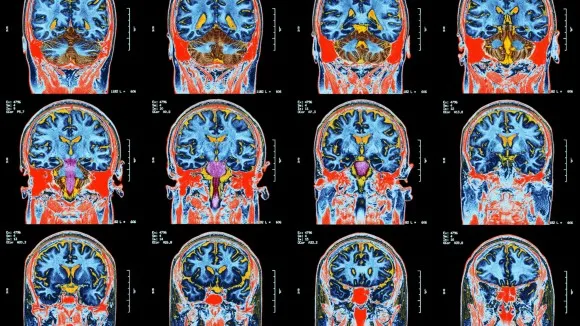
As medical imaging data becomes more accessible and deep learning tech advances, there’s a huge chance to craft AI tools that could transform how health diagnostics and treatment strategies are developed.
Why is this worth your effort? Medical image analysis is a cornerstone of healthcare, crucial for catching diseases early and starting treatments sooner.
By crafting deep learning models focused on this analysis, you’re not just aiding doctors in making sharper, faster diagnoses but also paving the way for better patient care and more tailored treatment approaches.
Deep learning shines in dissecting complex imagery to pull out vital details, which makes it perfect for navigating the intricate world of medical images.
Here’s how to kick off your deep learning medical image analysis project:
- Secure a dataset: Start with a hefty collection of medical images that have been marked by experts, showing what to look for.
- Prep your data: Standardize image sizes, adjust pixel values to a common scale, and use data augmentation to make your dataset even stronger and more varied.
- Develop your models: Train deep learning models, like convolutional neural networks (CNNs) or recurrent neural networks (RNNs), to unearth patterns in the images that correlate with specific health conditions.
- Measure and refine: Evaluate how well your models perform by looking at sensitivity, specificity, and accuracy, among other metrics. Keep tweaking your models to hone their ability to tackle real-world medical challenges.
24. Real-time lane detection
Real-time lane detection with AI is like giving vehicles the ability to see and understand the road, helping drivers (or the car itself, if it’s autonomous) stay safely within lane markings.
This project focuses on creating computer vision algorithms that process video from car-mounted cameras on the fly, spotting lane lines and figuring out where the vehicle should be heading.

As autonomous vehicles and advanced driver assistance systems (ADAS) become more common, the demand for smart lane detection tech is shooting up, promising to make roads safer and driving smoother.
Why dive into this project? Lane detection is a cornerstone of autonomous driving, crucial for keeping cars in their lanes, making sense of complex road scenarios, and avoiding run-ins with other vehicles or obstacles.
By putting together a system that does this in real time, you’re not just tinkering with cool tech; you’re helping push forward safer, more efficient transport options, cutting down accident risks and making the drive better for everyone.
Plus, this system could work hand in hand with existing ADAS features, like lane departure warnings and adaptive cruise control, beefing up vehicle safety features.
Here’s a step-by-step on how to build a real-time lane detection system:
- Gather video data: Start with footage from cameras on vehicles that show various driving conditions and lane setups.
- Process the video: Use image processing tricks like edge detection, color segmentation, and changing the perspective in the footage to make lane lines pop out clearly.
- Train your models: Develop computer vision models, maybe a convolutional neural network (CNN) or a semantic segmentation network, to recognize those lane markings and predict where the car should head, all in real time.
- Implement it: Hook up your lane detection model to a vehicle’s computer, where it can take in live camera feeds, analyze them in real time, and offer lane-keeping assistance.
25. CV analyzer with personality prediction
Developing a CV analyzer with personality prediction is like giving recruiters a crystal ball that not only sifts through resumes but also offers insights into the personalities behind them.
This AI-powered tool dives into the details of resumes—education, work history, skills—and then leverages natural language processing to pick up on the nuances in language that might hint at an applicant’s personality traits, based on psychological theories.
With job applications piling up and the hunt for the perfect candidate becoming more challenging, such a tool could revolutionize how recruiters screen and select potential hires.
Why is this project worth your time? Traditional resume screening often sticks to looking for keywords or relies heavily on human judgment, which can be slow and biased.
A CV analyzer equipped with personality prediction not only speeds up the hiring process but also introduces a more nuanced view of candidates, focusing on cultural fit and personal attributes alongside qualifications.
It adds depth to the screening process, highlighting aspects like a candidate’s preferred way of communicating, their approach to work, and how they might mesh with a team, enriching recruitment strategies and potentially boosting retention by aligning candidates more closely with company culture.
How to create a CV analyzer with personality prediction:
- Collect data: You’ll need a robust dataset of resumes linked with personality traits or outcomes from psychometric tests to train your system.
- Prepare the data: Extract and analyze text features from the resumes—think word use, sentence structure, sentiment—to capture the subtleties of the language that could reflect personality traits.
- Develop your models: Employ machine learning techniques such as support vector machines (SVMs), logistic regression, or neural networks to discern patterns that correlate resume content with personality traits.
- Craft a user interface: Incorporate your predictive models into an easy-to-use platform that allows recruiters to upload resumes and quickly get back data-driven personality insights and compatibility scores.
26. AI-powered assignment plagiarism checker
Creating an AI-powered assignment plagiarism checker means giving educators a powerful tool to automatically spot and call out plagiarism in student works like essays and research papers.
This system sifts through text, comparing it against a vast pool of sources to pinpoint similarities that might indicate copied content.
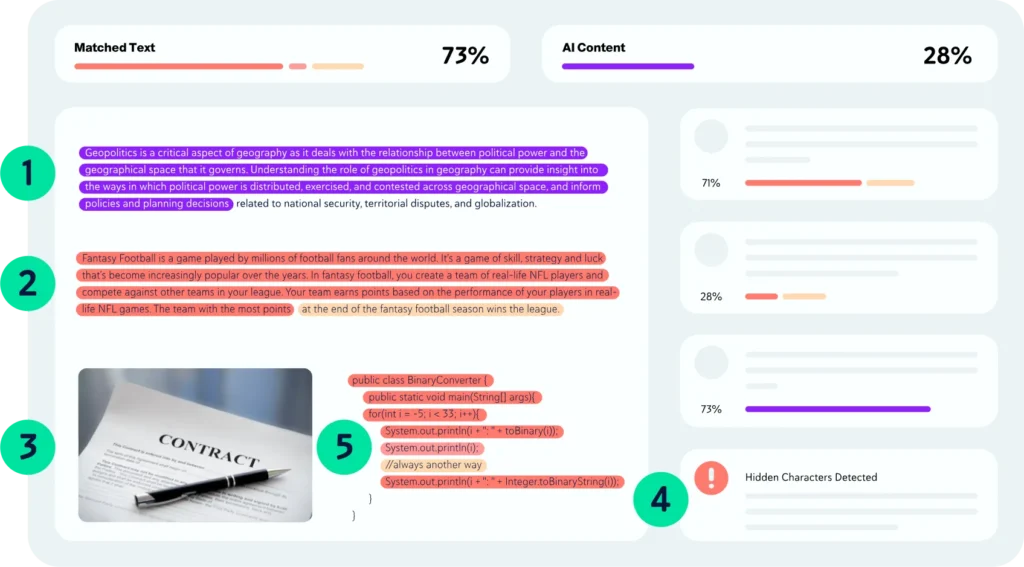
With online education booming and information just a click away, there’s a pressing need for robust solutions to uphold academic honesty and prevent plagiarism.
Why dive into this project? Plagiarism not only hurts academic integrity but also shortchanges students who put in genuine effort.
By crafting a sophisticated plagiarism checker, you’re not just helping educators catch cheaters; you’re reinforcing the value of original work and fair assessment.
Plus, AI-driven tools can scan assignments more thoroughly and quickly than humanly possible, freeing up educators to concentrate on guiding and mentoring their students.
Here’s how to kickstart your AI-powered plagiarism detection tool:
- Gather data: Collect a wide range of text documents—authentic student assignments and possible plagiarism sources—to train your detection system.
- Prep the texts: Break down the documents into manageable chunks, whittle them down to their roots, and convert them into numerical data that the AI can understand.
- Train models: Employ techniques like measuring similarity, creating text embeddings, or matching sequences to teach your system how to identify plagiarism by comparing how closely documents align.
- Deploy the tool: Embed your plagiarism detection models into a user-friendly online platform or academic software, letting educators upload assignments and instantly get detailed reports on potential plagiarism.
27. AI-bot for banking
Developing an AI-bot for banking means creating a smart virtual assistant that offers personalized banking help, answers queries, and streamlines financial operations—all through the power of artificial intelligence.
This AI system is designed to grasp natural language inputs, handle banking-related questions, and assist with tasks like checking account details, transferring funds, and paying bills.
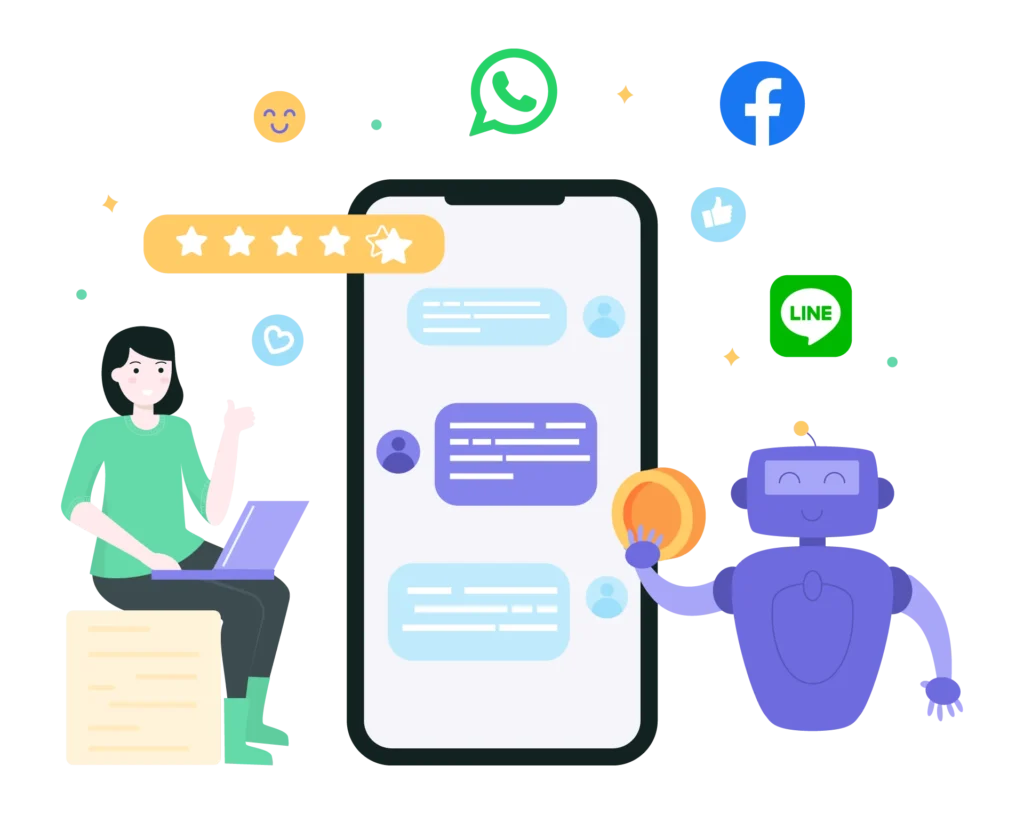
With digital banking on the rise and a push for better customer service, AI bots are in high demand to make banking interactions smoother and more engaging.
Why dive into this project? Traditional banking can be a hassle, with slow services, complicated processes, and limited support hours.
An AI-bot for banking changes the game by providing round-the-clock services, instant support, and tailored help, all via a chat interface.
Besides boosting customer happiness, AI bots can take over routine tasks, cut down on costs, and ramp up efficiency for banks and financial institutions.
Here’s how to start building your AI banking bot:
- Collect banking data: You’ll need data on customer accounts, transaction records, and common questions to teach your bot about banking.
- Prepare the data: Break down the text (tokenizing), clear out unnecessary words (stopwords), and turn the words into numbers (vectorizing) so your AI can learn from them.
- Train your models: Work with machine learning models focused on understanding natural language, recognizing user intentions, and managing dialogues, to equip your bot with the ability to grasp and respond to banking queries.
- Deploy the bot: Embed your fully trained bot into a banking app or website, giving customers a way to interact with the bot in real time for all their banking needs.
28. Facial emotion recognition
Facial emotion recognition with AI opens up a world where technology can see and interpret human emotions from facial expressions in real-time, offering tailored responses or actions.
This project involves creating computer vision algorithms that examine faces in photos or videos, pinpointing expressions, and identifying emotions like joy, sorrow, anger, or surprise.
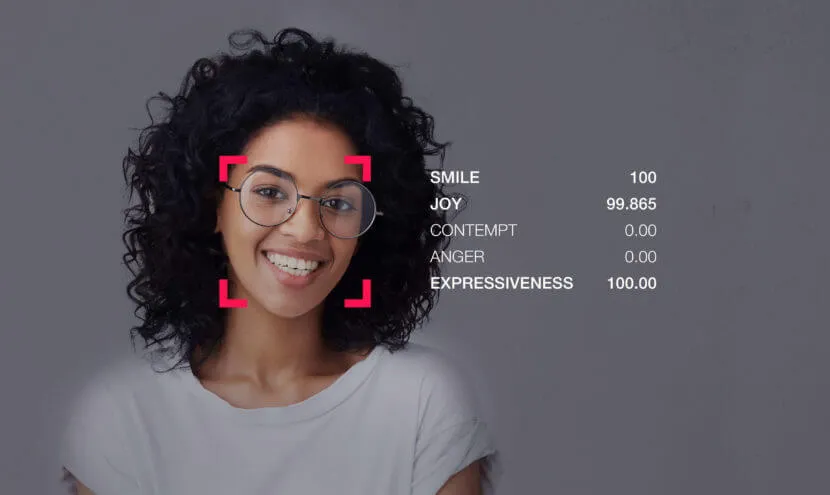
As interest in emotional intelligence and customized interactions grows, the demand for AI tools capable of empathizing and reacting to human feelings in areas such as marketing, healthcare, and education is on the rise.
Why venture into this area? Facial emotion recognition has vast potential applications, revolutionizing customer service, aiding in mental health care, and enhancing how we interact with computers.
By developing a system for recognizing emotions, you can open doors for businesses to connect with customers on a deeper level, offer personalized experiences, and even support mental health professionals in diagnosing and managing emotional and psychological conditions, leading to better care and healthier lives.
Here’s a roadmap to create a facial emotion recognition system:
- Collect labeled data: Start with a dataset of facial images or videos tagged with specific emotions, providing a foundation for training your model.
- Process the data: Detect faces in the images, align them for consistency, identify key facial points, and standardize the visuals to prepare for analysis.
- Develop machine learning models: Utilize advanced models like convolutional neural networks (CNNs), recurrent neural networks (RNNs), or graph neural networks (GNNs) to decipher the complex patterns in facial expressions that correspond to different emotions.
- Implement the solution: Embed your emotion recognition model into apps or gadgets where it can assess real-time visual data, offering immediate insights or adjustments based on the emotions it detects.
29. AI-based recommendation system for online learning resources
Building an AI-based recommendation system for online learning resources means crafting a smart tool that nudges learners towards courses, articles, videos, and exercises perfectly aligned with their interests, needs, and educational goals.
This system sifts through user interactions, preferences, and activity on e-learning platforms, employing machine learning to spotlight educational content that hits the mark for each individual.
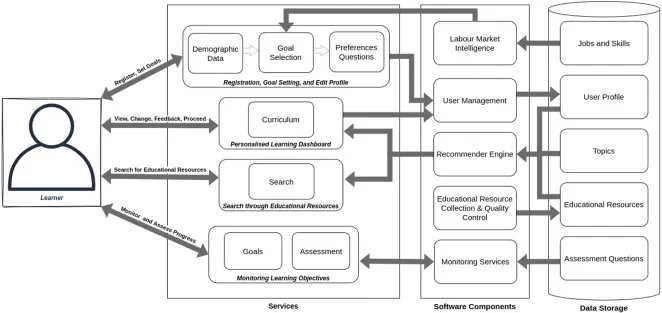
As online education grows and the sea of available resources expands, there’s a keen demand for AI solutions that can guide learners to quality content without the overwhelm.
Why embark on this project? Traditional search techniques for educational materials can be daunting, eating up time and often leaving learners adrift in a vast ocean of options.
An AI-driven recommendation engine streamlines this search, boosting engagement, ensuring content sticks, and tailoring the learning journey to fit each student’s unique pathway.
Beyond easing the search, such systems are proven to enhance educational outcomes, bump up course completion rates, and spark a drive for self-led learning.
Here’s a blueprint for creating an AI-based recommendation system for online learning:
- Gather user data: Collect information on how users interact with online learning platforms—what they browse, search for, enroll in, and their feedback on courses.
- Preprocess the data: Clean and organize the data, pulling out key features that shed light on user preferences and behaviors.
- Develop machine learning models: Utilize models like collaborative filtering, content-based filtering, or a blend of approaches to discern patterns in the data and tailor recommendations to each user’s profile.
- Implement the system: Embed your recommendation engine into the learning platform, where it can dynamically suggest personalized educational content based on ongoing user actions and preferences, enhancing the learning experience by connecting learners with the resources most relevant to their educational journey.
30. AI-powered virtual assistant for code debugging
Creating an AI-powered Virtual Assistant for Code Debugging means setting up a smart coding buddy that not only aids in writing code but also in spotting and fixing bugs.
This assistant dives into code snippets, flags errors, offers solutions, and explains where things went awry, all thanks to machine learning and natural language processing.
As software becomes more complex and the pace of development quickens, the tech world is keen for smarter tools to make debugging less of a headache, boosting developer efficiency and code quality.
Why embark on this project? Debugging is a critical yet time-intensive part of coding, involving hunting down and correcting mistakes to ensure software runs smoothly.
An AI-driven virtual assistant specialized in debugging could automate the grind, slashing the time developers spend chasing bugs and providing them with instant, actionable insights to tackle problems more efficiently.
Here’s a step-by-step to bring your AI debugging assistant to life:
- Gather code data: Start with a collection of code snippets marked with bugs, including what went wrong and how to fix it. This will be the foundation for teaching your assistant.
- Process the code: Break down and examine the code to pull out key aspects like syntax, structure, and semantics. This helps the assistant grasp the nuts and bolts of what makes code work (or not).
- Train machine learning models: Use algorithms that can classify types of bugs, sequence-to-sequence models for understanding and fixing errors, or reinforcement learning to get smarter with each debug. The goal is for the AI to learn from data how to spot mistakes and suggest fixes accurately.
- Integrate with IDEs or code editors: Embed your AI assistant into the tools developers already use, turning it into a real-time coding companion that flags errors, breaks down why they happened, and offers fixes as developers work.
How to begin a career in artificial intelligence
To begin a career in Artificial Intelligence, you need a blend of education, skills, and practical experience.
Here’s a roadmap to launch your AI career:
- Educational foundation: Start with a strong base in computer science, mathematics, or a related field. A degree in these areas is often essential, laying the groundwork for understanding complex AI concepts.
- Programming skills: Gain proficiency in programming languages crucial for AI, like Python, R, or Java. Python, in particular, is widely used in AI for its simplicity and the extensive libraries available for machine learning and data analysis.
- Learn AI principles: Dive into core AI subjects such as machine learning, neural networks, natural language processing, and computer vision. Online platforms like Coursera, edX, or Udacity offer courses designed by industry experts and universities.
- Hands-on projects: Apply what you’ve learned in practical projects. Whether it’s building machine learning models, developing chatbots, or working on data analytics, hands-on experience is invaluable. Participating in competitions on platforms like Kaggle can also sharpen your skills.
- Internships and work experience: Seek internships or entry-level positions that offer exposure to AI tasks. Real-world experience is critical for understanding the challenges and nuances of AI projects.
- Continuous learning: AI is a rapidly evolving field. Stay informed about the latest research, technologies, and tools. Follow AI news, attend workshops/conferences, and consider pursuing advanced degrees or certifications if necessary.
- Networking: Join AI communities, both online (LinkedIn, Reddit) and offline. Attend AI meetups, seminars, and conferences to connect with professionals in the field. Networking can lead to mentorship, collaboration opportunities, and job offers.
- Specialize: As you gain more knowledge and experience, consider specializing in an area of AI that particularly interests you, such as robotics, AI ethics, or healthcare AI. Specialization can make you more attractive to employers looking for experts in specific AI applications.
- Build an online presence: Showcase your projects, contributions to open-source, and your technical skills on platforms like GitHub. A strong online portfolio can attract potential employers or collaborators.
- Apply ethically: Understand the ethical implications of AI technologies. As you progress in your AI career, strive to develop solutions that are not only innovative but also responsible and beneficial to society.
Conclusion
Beginning a career in Artificial Intelligence (AI) is a thrilling adventure into an area full of possibilities for creativity and making a difference. You can work on many projects, from straightforward ones like analyzing feelings in text to more complicated tasks like studying medical images.
It’s important to carefully consider data use and ethical issues in AI. Always be eager to learn more, and by joining the AI field, you can help create a future where technology improves our lives.
What do you think or want to ask about starting in AI? Leave your thoughts or questions below!
Frequently Asked Questions (FAQs)
What are some good AI projects for beginners?
Begin with simple projects like image classification, sentiment analysis, or creating a basic chatbot. These introduce you to AI with minimal coding needed.
How do AI projects contribute to career development?
AI projects enhance technical, problem-solving, and critical thinking skills, making you more attractive to employers and opening up career opportunities.
What are the common challenges in AI project implementation?
Challenges include dealing with poor data quality, choosing appropriate algorithms, facing computational limits, and ensuring the AI integrates well with existing systems.
How can one stay updated on the latest AI project ideas and trends?
Follow AI blogs and industry news, join AI communities on social media, attend conferences, and participate in online courses and webinars.
What are some ethical considerations to keep in mind when working on AI projects?
Focus on fairness, avoid bias, ensure data privacy and security, maintain transparency and accountability, and consider the societal impact of AI technologies.

